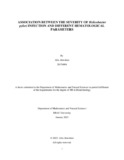| dc.contributor.advisor | Hossain, Dr. Mahboob | |
| dc.contributor.author | Abreshmi, Afra | |
| dc.date.accessioned | 2024-01-17T09:19:18Z | |
| dc.date.available | 2024-01-17T09:19:18Z | |
| dc.date.copyright | 2023 | |
| dc.date.issued | 2023-01 | |
| dc.identifier.other | ID: 20176004 | |
| dc.identifier.uri | http://hdl.handle.net/10361/22180 | |
| dc.description | This thesis report is submitted in partial fulfillment of the requirement for the degree of Master of Science in Biotechnology, 2023. | en_US |
| dc.description | Cataloged from PDF version of thesis. | |
| dc.description | Includes bibliographical references (pages 25-28). | |
| dc.description.abstract | Helicobacter pylori infection is a global public health problem that is affecting both developed
and developing countries. Approximately 50% (over 3 billion) of the world's population is infected
with Helicobacter pylori, mainly in developing countries. H. pylori is a gram-negative bacterium
that is commonly found in the stomach. The vast majority of H.pylori-infected people show no
symptoms and never develop any problems. However, this bacterium is capable of causing ulcers
and less commonly stomach cancer. Recently, its association with some hematological
abnormalities has been found. Compared to other developing countries, in Bangladesh, the rate of
H. pylori infection is particularly high. However, limited studies have been conducted regarding
the relationship between hematological parameters with H. pylori infection in Bangladesh. Thus,
the objective of our study was to determine the correlation between different selected
hematological parameters and H. pylori infections of different intensities. A total of 697 patients,
290 males, and 407 females, who were suspected H. pylori patients, were included in the study.
The suspected patients infected with H. pylori titer less than 30 U/ml were considered H. pylori negative and more than 30 U/ml were under H. pylori-positive group. Patients in H. pylori-positive
group were divided into a subgroup of severe intensity (titer more than 50 U/ml). Our study found
a weak positive correlation between Lymphocyte and H.pylori (p= 0.0253*) and between
Neutrophil to Platelet ratio (NPR) and H.pylori (p=0.008*) in the H.pylori-positive group. In the
sub-group of severe intensity, a weak positive correlation between Hemoglobin and H.pylori (p=
0.01126*) and between NPR and H.pylori (p= 0.0362*) was observed. There was a very weak
negative correlation found between Platelet and H.pylori (p= 0.0005*) and between Platelet to
Lymphocyte ratio (PLR) and H.pylori (p= 0.0001*) in the H.pylori-positive group. In the severe
intensity group, a weak negative correlation between Platelet and H.pylori (p= 0.01074*) and
between PLR and H.pylori (p= 0.0034*) was observed. | en_US |
| dc.description.statementofresponsibility | Abreshmi, Afra | |
| dc.format.extent | 28 pages | |
| dc.language.iso | en | en_US |
| dc.publisher | Brac University | en_US |
| dc.rights | Brac University theses are protected by copyright. They may be viewed from this source for any purpose, but reproduction or distribution in any format is prohibited without written permission. | |
| dc.subject | H. pylori infection | en_US |
| dc.subject | Hematological parameters | en_US |
| dc.subject | Correlation | en_US |
| dc.subject | Regression analysis | en_US |
| dc.subject.lcsh | Helicobacter pylori infections--Laboratory manuals. | |
| dc.title | Association between the severity of helicobacter pylori infection and different hematological parameters | en_US |
| dc.type | Thesis | en_US |
| dc.contributor.department | Department of Mathematics and Natural Sciences, Brac University | |
| dc.description.degree | M. Biotechnology | |

